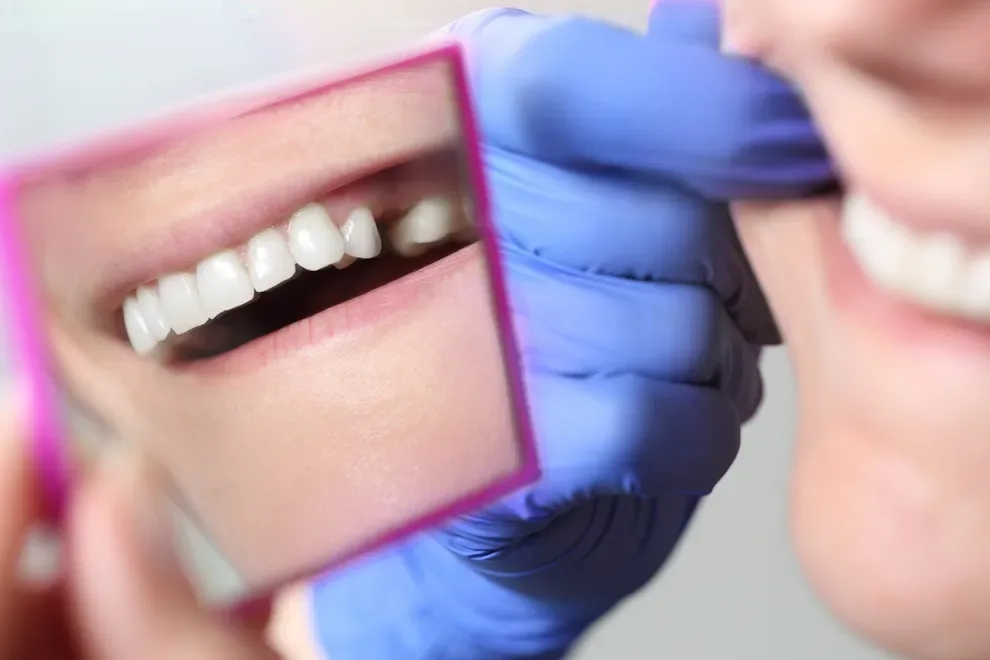Can I Live With a Missing Tooth? Potential Complications & What to Do

Table of Contents
- Complications
- Does Tooth Location Matter?
- How Long Can You Go?
- Tooth Replacement Options
- References
Losing a tooth can be a very stressful event for anyone, whether it’s due to injury, longtime decay, or periodontitis (gum disease). But there’s no need to feel shamed or alone. Missing teeth are very common.
Although tooth loss and decay are preventable in most cases, and the numbers are improving, most adults will not make it through their entire life with a full set of teeth. In fact, the average person ages 20 to 64 has at least three badly decayed or missing teeth.
After losing a tooth, many people are unsure of what to do next. Some may be inclined to consider just living with the missing tooth, especially if they’re older in age or if the tooth is in the back and not highly visible.
But the effects of living with a lost tooth are about more than just aesthetics. Missing teeth can have an impact on your oral and overall health, as well as your well-being — no matter how old you are.
Today, there are many options available to ensure that losing a tooth doesn’t mean you have to sacrifice your smile or quality of life.
Complications of not replacing a missing tooth
While concern about the immediate effects of a missing tooth (worrying about whether it’s unsightly and dealing with the immediate mouth trauma) is a normal reaction to a lost tooth, there are also more short-term and long-term complications to consider. Here are some of them:
Having a new and unnatural gap between teeth can cause difficulty with chewing and eating. Certain foods may irritate the gums or become harder to chew.
This can cause a person with a missing tooth to change their diet, often cutting out nutrient-packed foods like meats, vegetables, and nuts and instead turning to softer or sweeter foods that may be easier to chew but low in nutritional value.
This is especially of concern for aging adults who are at the highest risk of tooth loss and may begin to suffer from malnutrition if they make negative changes to their diet due to missing teeth.
A missing tooth can change the way an individual speaks, making it harder for them to communicate and impacting their day-to-day life.
Just one missing tooth can create a gap that can cause someone’s bite to shift. This can cause teeth to migrate and result in alignment and orthodontic problems, such as crooked teeth and a misaligned bite.
Missing teeth can increase the risk of tooth decay and periodontitis (gum disease) in a few ways.
Teeth that have shifted as a result of the gap caused by the missing tooth may be harder to clean, resulting in more plaque and bacteria buildup that can lead to further decay or tooth loss.1
A misaligned smile from the teeth shifting can cause someone’s bite to become off. This can cause problematic bite patterns that can cause gum and inner cheek irritation, resulting in increased inflammation — a major cause of oral health problems and general chronic health conditions.
The gap caused by a missing tooth can itself become an area prone to plaque and bacteria buildup and affect surrounding teeth as well.
A missing tooth can change the shape of your mouth as teeth shift. Missing teeth can also affect the stability of the jaw and mouth, increasing the risk of future oral health problems and further tooth loss.
When you bite with your tooth, the force of that bite sends messages through your jawbone to osteoblasts (cells responsible for the formation and mineralization of bone) to keep the bone there strong.
When you lose a tooth, those stimuli are no longer received, and the osteoblasts may no longer work to regenerate and strengthen the bone in the area. This can result in bone loss around the missing tooth that may worsen over time, even resulting in a sagging smile.
Having a missing tooth can make an individual feel ashamed and self-conscious. The other consequences of missing teeth, such as the effect on eating and speaking, can create feelings of depression and anxiety.
Does the location of a missing tooth matter?
While some may worry more about a highly visible missing tooth (like a front tooth), the serious consequences of a missing tooth — including an increased risk of decay, a negative impact on eating and speaking, and possible bone loss — will impact an individual no matter where the missing tooth is.
How long can you go without replacing a missing tooth?
In most cases, it’s never too late to replace a missing tooth. But the earlier a missing tooth is replaced, the better.
Early intervention prevents teeth shifting and the decay and irritation that can accompany it. Replacing it quickly can also prevent bone loss and stop poor eating and speaking habits before they form as a result of the missing tooth.
Options for replacing a missing tooth
There are three main options for replacing a missing tooth.
Dental implant: A porcelain crown (designed to match surrounding teeth) is placed over a screw and cap that has been implanted in the mouth to replace the tooth root. The process for a dental implant will include ensuring that the jawbone is strong enough to support an implant. If it’s not strong enough, a surgical procedure of augmenting the jawbone with bone or bone-like material may be required.
Bridge: Artificial teeth are fused to a metal frame and attached to supporting nearby teeth or implants.
Dentures: Removable dental devices replace all or some missing teeth. These are generally only used in cases of multiple missing teeth or when all the teeth are missing.
